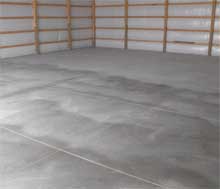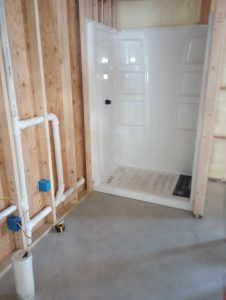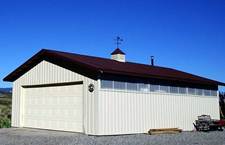How to Properly Apply Post Frame Building Concrete Sealant
Condensation in post frame buildings can be problematic. In order to reduce condensation probabilities, minimizing water vapor sources proves to be paramount. Concrete slabs, especially if no vapor barrier was placed beneath them, are a prime source of water vapor. Proper application of sealant can greatly reduce or eliminate water vapor transmission from slab into the building.
Concrete sealant will make your concrete more resistant to weather exposure, water, grease and oil stains, abrasion and deicing salts. What’s more, they will help to make it easier to clean. But in order for a sealer to work its magic, it must be applied properly. Each step, from surface preparation to choosing right application method for product, will have a big impact on final outcome.
Following are some tips for applying concrete sealer properly. Whichever brand of sealant you use, be sure to follow specific instructions recommended by product manufacturer, since they may differ from general guidelines given here.
 When you apply sealer can be important as well. Allow new concrete to cure completely (28 days or more, as recommended). Most sealers must be applied under dry conditions, since applying sealant to damp concrete could cause haziness or loss of adhesion. Air temperatures are also important and should typically be above 50°F during and for 24 hours or more after sealer application. Always allow sealer to dry completely before exposing it to foot or vehicle traffic. Drying times before exposure to heavy traffic can be as long as three days.
When you apply sealer can be important as well. Allow new concrete to cure completely (28 days or more, as recommended). Most sealers must be applied under dry conditions, since applying sealant to damp concrete could cause haziness or loss of adhesion. Air temperatures are also important and should typically be above 50°F during and for 24 hours or more after sealer application. Always allow sealer to dry completely before exposing it to foot or vehicle traffic. Drying times before exposure to heavy traffic can be as long as three days.
Surface preparation before applying a sealant will be extremely important. All oil, grease, stains, dirt, and dust must be removed or they may prevent sealer from adhering properly. Some manufacturers recommend etching surface first with an etching solution to ensure best adhesion.
Two most common methods of applying sealant to concrete surfaces are by roller or sprayer, often depending upon whether choosing a solvent or water based sealer. Always refer to manufacturer’s specific application guidelines.
Regardless of application method always strive for maximum coverage. Typical coverage rate should be 250 to 300 square feet per gallon, depending upon concrete porosity. Most important rule to remember – it’s best to apply two thin coats, making sure sealant doesn’t puddle or form uneven, thick areas. When applying a second coat of sealant, apply it in opposite direction (or perpendicular) to first coat to ensure even coverage. Wait to apply second coat of sealant for 24 hours or time recommended by the manufacturer.









Could you please comment on more advanced sealers such as the Ashford Formula?
I have no personal experience with products such the Ashford Formula. Here is what I have found in my research:
Ashford Formula is a colorless, transparent liquid that penetrates concrete and masonry building materials, protecting, preserving, and strengthening them. It does this by solidifying the components of the concrete into one solid mass. The effect is to increase density, toughen, harden, and seal out moisture for the life of the building material.
Ashford Formula seals masonry, concrete, and other portland cement based materials into a mass that is solid, rather than porous. Its penetrating quality provides deep sealing that is effective for the life of the concrete. This creates a floor surface that will be easy to clean and maintain.
Freshly finished concrete surfaces require no surface preparation if the Ashford Formula is to be applied immediately after the finishing operation as a curing agent. On areas where forms are recently removed, all form oil and breaking compound residue must be removed so as not to inhibit the penetration of the Ashford Formula into the surface.
The floor should have a normal clean look or a slight gloss. Floors with broomed or rough-texture finishes will not produce a sheen due to the textured surface finish. Use caution to protect the floor as stains may still occur during the first 6 to 12 months. Routine detergent scrubbing will lighten and leach out stains as the sealing process completes.
I am making a pole barn garage. And I was wondering if I should be putting a sealer around the cement that the Poles are embedded in? Please.
Everett
While you could, there would be no actual reason to do so. Concrete (cement) does not cause properly pressure preservative treated wood to decay.